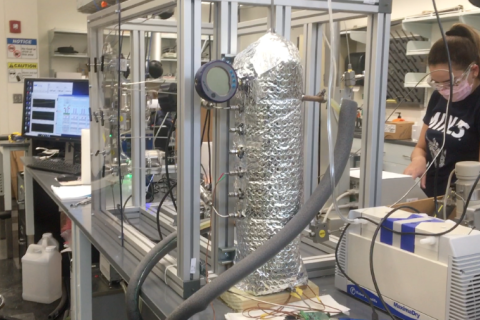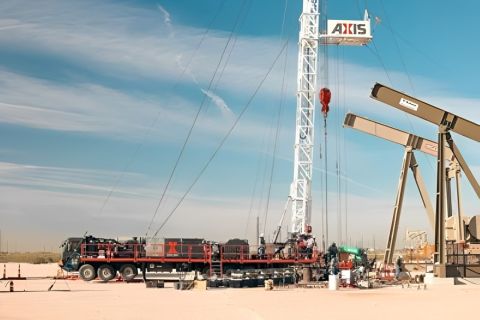 The Colorado School of Mines Reservoir Characterization Project (RCP) is conducting time-lapse multicomponent seismic surveys at Rulison field, Piceance Basin, Colorado, to identify and monitor fracture zones in tight gas sands. Multicomponent seismic monitoring is being conducted in a tight gas development project for the first time, as downspacing to 10 acres is occurring. The purpose of the time-lapse study is to use dynamic reservoir characterization to develop workflows and improve recovery efficiency in tight gas reservoirs.
The Colorado School of Mines Reservoir Characterization Project (RCP) is conducting time-lapse multicomponent seismic surveys at Rulison field, Piceance Basin, Colorado, to identify and monitor fracture zones in tight gas sands. Multicomponent seismic monitoring is being conducted in a tight gas development project for the first time, as downspacing to 10 acres is occurring. The purpose of the time-lapse study is to use dynamic reservoir characterization to develop workflows and improve recovery efficiency in tight gas reservoirs.
Multicomponent seismic surveys at Rulison field
Rulison field produces out of Cretaceous Mesaverde tight gas sandstones. The pay section spans a 1,200-ft (366-m) interval that is overpressured. The reservoirs consist of multiple-stacked lenticular sandstone bodies with matrix permeabilities ranging from 5 microdarcies (md) to 80 md. Williams Production Company, operator, is conducting an infill drilling program to reduce well spacing in the RCP study area.
Natural fractures significantly enhance the relative permeability to gas. Permeability enhancement through hydraulic fracturing is greatest when the hydraulic fracture stimulation connects the natural fracture network to the well bore.
The goal of RCP Phase 10 was to determine if multicomponent seismic data could detect natural fractures that control production at Rulison field. Two multicomponent (9-C) seismic surveys were acquired during this phase. The Phase 10 surveys were acquired in the same general location as a 3-D P-wave survey shot by the Department of Energy (DOE) in 1996. In addition, a regional 50-sq-mile (193-sq-km) 3-D survey, shot by Seitel in 2001, overlapped the study area and was used to interpret the structural framework of the area.
Conventional compressional-wave (P-wave) seismic data has done little to augment this play. Multicomponent seismic data were shot by RCP to determine if shear (S) waves would detect fracture zones that control the permeability structure in the reservoir. Most wells are completed in multiple zones starting 300 ft (92 m) below the UMV shale and extending into the Cameo interval. The data indicate the presence of a wrench fault that is clearly imaged on the S-wave data, whereas it is not noticeable on the P-wave vertical section. Gas masks the presence of the faults, and the better zones for tight gas exploration and development may be in those areas not well defined with P waves. The source of the gas is primarily from coals in the Cameo interval, and these coals appear on both P- and S-wave data. Gas, on the other hand, affects primarily P-wave data. The most noticeable contrast between P- and S-wave data occurs in the middle of the reservoir interval between the UMV shale to Cameo and within the Cameo itself.
There is overpressure in Rulison field due to gas generation. Depletion of pressure above the coals in the reservoir interval has the potential to create remigration of gas from the coals into the overlying reservoir interval. Remigration through the fracture network is a possible explanation for abnormally high-productivity wells that are connected through the fracture system. Time-lapse difference mapping of the Cameo coal interval between the 1996 and a 2003 monitor survey supports the hypothesis of remigration. There is a possible spatial correlation between the wells with higher expected ultimate recovery (EUR) and the time-lapse anomalies evident in the monitor survey.
Fracture detection at Rulison
The seismic character in the reservoir interval from the UMV to Cameo is different between P waves and S waves due to the different impedance that is affecting the seismic response of these two wave modes. Shear waves are affected by rigidity, whereas P waves are affected by compressibility and rigidity. P waves are sensitive to the presence of gas, which affects bulk compressibility. Shear waves are unaffected by gas and are better for imaging this gas reservoir. Another significant factor is fractures. Shear waves are much more sensitive to fractures than P waves. Changes in the reflectivity of shear waves can be attributed to changes in
rigidity caused by fractures.
Fractures are concentrated in areas where stress relief occurs. To confirm the presence of natural fractures, we looked at two multicomponent seismic attributes: Vp/Vs, and anisotropy. Research has determined that areas of low Vp/Vs1 correspond to areas of high gas saturation. This is an important new exploration technology for tight gas that has developed from our Phase 10 study.
An anisotropy map was created by computing root mean square amplitude over a 50-millisecond window on both the fast and slow shear waves in the middle part of the reservoir interval and differencing them. Amplitudes are used to derive thin bed anisotropy. High anisotropy regions in the central portion of the map are related to fracture zones associated with wrench faults. The high EUR wells fall in the high anisotropy regions corresponding to zones of high fracture density. Time-lapse seismic data were analyzed between the three P-wave data sets. An important observation was that some faults are leaking gas from the Cameo interval. A similar observation was reported in analysis of the 2003 and 1996 surveys. These anomalies are related to zones where there is a change in differential pressure in the Cameo interval with time. Gas is remigrating upward into the reservoir interval through faults and fractures and is escaping from the coals because the pressure is being drawn down through production. A pressure sink is in the vicinity of the Clough 19 well where shear wave velocity anisotropy anomalies occur. Gas may be drawn into this highly productive "sweet spot" area because the highly interconnected framework of fault and fractures is giving rise to prolonged production due to gas remigration.
Time-lapse seismic data were analyzed between the three P-wave data sets. An important observation was that some faults are leaking gas from the Cameo interval. A similar observation was reported in analysis of the 2003 and 1996 surveys. These anomalies are related to zones where there is a change in differential pressure in the Cameo interval with time. Gas is remigrating upward into the reservoir interval through faults and fractures and is escaping from the coals because the pressure is being drawn down through production. A pressure sink is in the vicinity of the Clough 19 well where shear wave velocity anisotropy anomalies occur. Gas may be drawn into this highly productive "sweet spot" area because the highly interconnected framework of fault and fractures is giving rise to prolonged production due to gas remigration.
The "sweet spot" is an area of natural fractures that is connected to the Cameo source beds. Areas of high connectivity and high storage capacity are the better reservoir. An exploration strategy in this setting is to find the faults using multicomponent seismology and then high-grade the better reservoir components through a combination of Vp/Vs measurements and shear wave azimuthal anisotropy. A development strategy is to identify these sweet spots early and connect wells through hydraulic fracturing to the natural fracture systems. This development strategy should be monitored in the early phases of development with time-lapse multicomponent seismology to accelerate production from the better-quality reservoir first. Predicting natural fracture swarms and high production sweet spots is critical to the economics of unconventional gas plays.
Synthesis
Our Rulison Phase 10 study brings several new exploration and development concepts into focus. Seismic is generally not used in this play, but our work shows it has tremendous potential. Prior work showed a correlation between the faults and better EUR wells, but no quantitative correlation emerged, as the faults could not be seen in the reservoir.
Time-lapse seismology shows these faults for the first time. We see northeast and northwest faults along with fault intersections. These are indicative of fault blocks that are currently undergoing stress reorientation by the present day stress field.
Faults and fractures at Rulison are products of older tectonism and are rejuvenated by the present-day stress system. Multicomponent time-lapse seismic data assists us in the prediction of the open fracture systems and their control on reservoir permeability and production.
Research indicates that fault block rotation caused by present-day stress creates high fracture density at fault intersections and that intersecting fracture networks enhance the permeability of this reservoir.
The technology that ties this work together is time-lapse seismology. Land 4-D seismic data at Rulison field is capable of detecting leaking faults, migration pathways, zones of high fracture connectivity, zones of depletion and potential bypassed pay. Time-lapse multicomponent seismology has the potential to pay for itself many times over through improving recovery efficiency. Time-lapse anomalies are generally related to pressure depletion in this reservoir.
Recommended Reading
Defeating the ‘Four Horsemen’ of Flow Assurance
2024-04-18 - Service companies combine processes and techniques to mitigate the impact of paraffin, asphaltenes, hydrates and scale on production—and keep the cash flowing.
Going with the Flow: Universities, Operators Team on Flow Assurance Research
2024-03-05 - From Icy Waterfloods to Gas Lift Slugs, operators and researchers at Texas Tech University and the Colorado School of Mines are finding ways to optimize flow assurance, reduce costs and improve wells.
AI Poised to Break Out of its Oilfield Niche
2024-04-11 - At the AI in Oil & Gas Conference in Houston, experts talked up the benefits artificial intelligence can provide to the downstream, midstream and upstream sectors, while assuring the audience humans will still run the show.
Axis Energy Deploys Fully Electric Well Service Rig
2024-03-13 - Axis Energy Services’ EPIC RIG has the ability to run on grid power for reduced emissions and increased fuel flexibility.
Curtiss-Wright to Deploy Subsea System at Petrobras' Campos Field
2024-02-12 - Curtiss-Wright and Petrobras will combine capabilities to deploy a subsea canned motor boosting system at a Petrobras production field in the Campos Basin.





